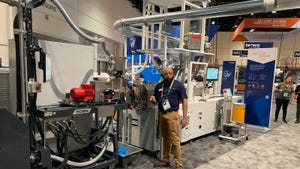Reactive Extrusion Aids Bottle-to-bottle Recycling
February 28, 2003
Hitachi Zosen Corp., Tokyo, has coupled a twin-screw extruder with an extrusion blow molding press to create a bottle-to-bottle recycling system for pet containers. A machine configured for multilayer bottles costs ¥90 million ($760,000) and has an hourly output of 1200 500-mL bottles.
Crushed pet flakes from bottles are fed to the corotating, twin-screw reactive extruder together with calcium stearate catalysts and an epoxy-based coupling agent for chain extension. FTEX, Yokohama, Japan, developed the reactive extrusion technology (Aug 01 mp/mpi, 39) and supplies the coupling agent.
Untreated pet flakes normally have a melt flow ratio (mfr) of 50 to 200 and an intrinsic viscosity (iv) of 0.60 to 0.75, which limit their application to fibers, biaxially-oriented films, and injection molded containers. FTEX’s coupling agent boosts iv to 1.1 to 1.2, making the flakes suitable for bottle molding. mfr can be tailored to 0.1 to 10 g/10 min.
The melt from the extruder passes through a screenchanger prior to blow molding. Katsumasa Yamada, Hitachi Zosen’s plastics machinery general manager, says pet supplied from recycling centers varies in quality and often contains metallic impurities. Preforms are extrusion blow molded, since the high pressures of injection molding would damage the screenchanger. Also, coextrusion yields multilayer preforms.
The all-electric blow molding station is made by Tahara Machinery, which Hitachi Zosen acquired in 2000. Parisons are first extrusion blow molded into preforms, then stretch blow molded. Bottles’ necks are formed on the preforms. Top stretch pin stroke is 280 mm.
Hitachi stresses the removal of impurities near preform molding, whereas most injection stretch blow molding machine makers consider mechanical separation prior to feeding the flakes into the machine to be sufficient.
Aoki Technical Laboratory and Nissei ASB, both in Nagano, Japan, each say its stretch blow machinery can handle recycled pet flake. Aoki recommends a metal separator, followed by an agitator/dryer to rid the agglomerated flakes of moisture, and an agitator hopper feed to a vented injection barrel. Nissei ASB says with proper predrying, a vented barrel is not required.
You May Also Like


